All the solutions provided in McGraw Hill My Math Grade 3 Answer Key PDF Chapter 9 Lesson 3 Multiply Three Factors will give you a clear idea of the concepts.
McGraw-Hill My Math Grade 3 Answer Key Chapter 9 Lesson 3 Multiply Three Factors
Build It
Find (2 × 3) × 3.

Draw and label the models.

2. Multiply the factors inside the parentheses first.
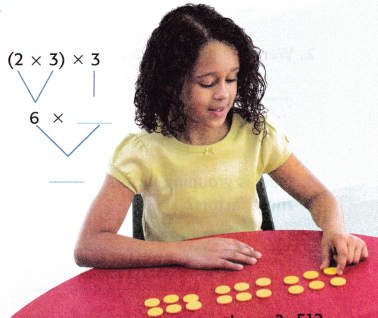
3. Multiply the product by the remaining factor.
Answer: 
Explanation:
Given, ( 2 × 3 ) × 3
Multiply the factors inside the parentheses first.
6 × 3 = 18
So, ( 2 × 3 ) × 3 = 18.
Try It
Group the same factors another way. Find 2 × (3 × 3).

Draw and label the models.
2. Multiply the factors in the parentheses first.
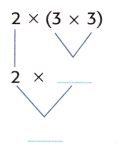
3. Multiply the product with the remaining factor.
So, 2 × (3 × 3) = ______________ also.
Either way you group the factors, the product is ______________.
Answer: the product is 18
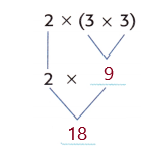
Explanation:
Given, 2 × (3 × 3)
Multiply the factors inside the parentheses first.
2 × 9 = 18
So, 2 × (3 × 3 ) = 18.
Talk About It
Question 1.
Mathematical PRACTICE Stop and Reflect Compare the models from each activity. How are they similar? How are they different?
Answer: (2 × 3) × 3 and 2 × (3 × 3)
Explanation:
Given, ( 2 × 3) × 3 and 2 × (3 × 3)
( 2 × 3) × 3
Multiply the factors inside the parentheses first.
6 × 3 = 18
or
2 × (3 × 3)
Group the same factors another way.
2 × 9 = 18
Either way the result of the product is same.
Question 2.
Were the products different in the two examples? Explain.
Answer: The products will be same
Explanation:
Given, ( 2 × 3) × 3 and 2 × (3 × 3)
( 2 × 3) × 3
Multiply the factors inside the parentheses first.
6 × 3 = 18
or
2 × (3 × 3)
Group the same factors another way.
2 × 9 = 18
Either way the result of the product is same.
Question 3.
How is grouping factors helpful when multiplying three or more factors?
Answer: Sometimes you can find patterns that make the multiplying easier.
Explanation:
For example, 4 x 7 x 25
If you multiplied in order (4 x 7) x 25, you’d come up with 28 x 25,
which isn’t that easy to do in your head.
If you regroup, (4 x 25) x 7, you come up with 100 x 7,
which is easier to get 700 from.
So, Sometimes you can find patterns that make the multiplying easier.
Practice It
Find each product.
Question 4.
3 × (2 × 2) = _______________
Answer: 3 × (2 × 2) = 12
Explanation:
Given, 3 × (2 × 2)
Multiply the factors inside the parentheses first.
3 × 4 = 12
So, 3 × (2 × 2) = 12.
Question 5.
1 × (4 × 2) = _______________
Answer: 1 × (4 × 2) = 8
Explanation:
Given, 1 × (4 × 2)
Multiply the factors inside the parentheses first.
1 × 8 = 8
So, 1 × (4 × 2) = 8.
Question 6.
(5 × 2) × 2 = ________________
Answer: (5 × 2) × 2 = 20
Explanation:
Given, (5 × 2) × 2
Multiply the factors inside the parentheses first.
10 × 2 = 20
So, (5 × 2) × 2 = 20.
Question 7.
(5 × 1) × 3 = ________________
Answer: (5 × 1) × 3 = 15
Explanation:
Given, (5 × 1) × 3
Multiply the factors inside the parentheses first.
5 × 3 = 15
So, (5 × 1) × 3 = 15.
Question 8.
4 × (2 × 3) = ________________
Answer: 4 × (2 × 3) = 24
Explanation:
Given, 4 × ( 2 × 3 )
Multiply the factors inside the parentheses first.
4 × 6 = 24
So, 4 × ( 2 × 3 ) = 24.
Question 9.
(3 × 3) × 3 = ________________
Answer: (3 × 3) × 3 = 27
Explanation:
Given, (3 × 3) × 3
Multiply the factors inside the parentheses first.
9 × 3 = 27
So, 3 × ( 3 × 3 ) = 27.
Question 10.
(4 × 3) × 2 = ________________
Answer: (4 × 3) × 2 = 24
Explanation:
Given, (4 × 3) × 2
Multiply the factors inside the parentheses first.
12 × 2 = 24
So, (4 × 3) × 2 = 24.
Group the factors another way. Then find each product.
Question 13.
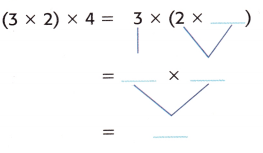
Answer: 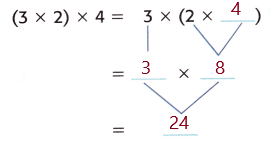
Explanation:
Given, ( 3 × 2 ) × 4 = 3 × ( 2 × 4 )
Multiply the factors inside the parentheses first.
6 × 4 = 24
So, ( 3 × 2 ) × 4 = 24.
Question 14.
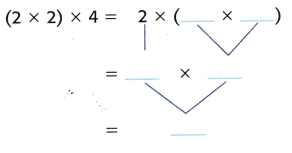
Answer: 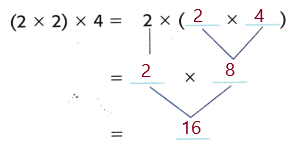
Explanation:
Given, ( 2 ×2 ) × 4
Multiply the factors inside the parentheses first.
4 × 4 = 16
So, ( 2 × 2 ) × 4 = 16.
Question 15.
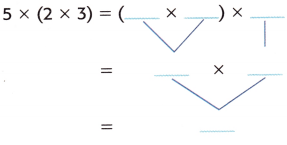
Answer: 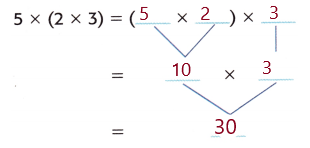
Explanation:
Given, 5 × ( 2 × 3 )
Multiply the factors inside the parentheses first.
5 × 6 = 30
So, ( 5 × 2 ) × 3 = 30.
Question 16.
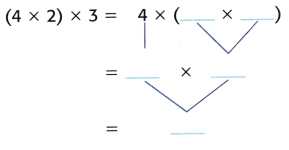
Answer: 
Explanation:
Given, 4 × ( 2 × 3 )
Multiply the factors inside the parentheses first.
4 × 6 = 24
So, ( 4 × 2 ) × 3 = 24.
Question 17.
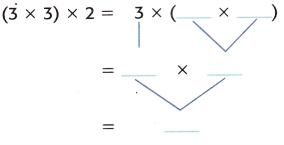
Answer: 
Explanation:
Given, 3 × ( 3 × 2 )
Multiply the factors inside the parentheses first.
3 × 6 = 18
So, ( 3 × 3 ) × 2 = 18.
Question 18.
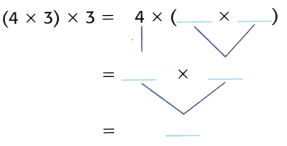
Answer: 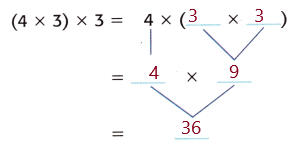
Explanation:
Given, 4 × ( 3 × 3 )
Multiply the factors inside the parentheses first.
4 × 9 = 36
So, ( 4 × 3 ) × 3 = 36.
Apply It
Question 19.
Mathematical PRACTICE Use Number Sense A hardware store carries 3 kinds of bolts. James buys 3 boxes of each kind of bolt. Each box costs $5. How much did James spend at the hardware store?

Answer: James spent $45 at the hardware store
Explanation:
Given, A hardware store carries 3 kinds of bolts.
James buys 3 boxes of each kind of bolt.
Each box costs $5.
That makes , (3 × 3) × 5
Multiply the factors inside the parentheses first.
9 × 5 = 45
So, ( 3 × 3 ) × 5 = 45.
Hence, James spent $45 at the hardware store
Question 20.
Cody walked his dog 2 times a week for 5 weeks. After every walk, Cody gave his dog 2 treats. How many treats did Cody’s dog get after 5 weeks?
Answer: Cody’s dog got 20 treats after 5 weeks
Explanation:
Given, Cody walked his dog 2 times a week for 5 weeks.
After every walk, Cody gave his dog 2 treats.
That makes , 2 × ( 5 × 2 )
Multiply the factors inside the parentheses first.
2 × 10 = 20
So, ( 2 × 5 ) × 2 = 20.
Hence, Cody’s dog got 20 treats after 5 weeks
Question 21.
Each van has 5 rows of seats with room for 3 passengers in each row. There are 2 vans and every row is filled. How many passengers are there altogether?
Answer: 30 passengers are there altogether
Explanation;
Given, Each van has 5 rows of seats with room for 3 passengers in each row.
There are 2 vans and every row is filled.
That makes, 5 × ( 3 × 2 )
Multiply the factors inside the parentheses first.
5 × 6 = 30
So, ( 5 × 3 ) × 2 = 30.
Hence, 30 passengers are there altogether
Question 22.
There are 4 rooms in each apartment and there are 3 apartments on each floor. How many rooms are there on 2 floors?
Answer: There are 24 rooms on 2 floors
Explanation:
Given, There are 4 rooms in each apartment and there are 3 apartments on each floor.
That makes , 4 × 3 = 12
For 2 floors , it will be 12 × 2 = 24
So, There are 24 rooms on 2 floors
Question 23.
Mathematical PRACTICE Find the Error Sam described the multiplication sentence below as four groups of f0u two times. Find and correct his mistake.
4 × (2 × 2)
Answer: its a group of 2 ‘s and a 4
Explanation:
Given, ( 4 × 2 ) × 2
Multiply the factors inside the parentheses first.
8 ×2 = 16
So, ( 4 × 2 ) × 2 = 16.
its a group of 2 ‘s and a 4
Write About It
Question 24.
Explain the difference between finding the product of 3 × (2 × 2) and finding the product of (3 × 2) × 2.
Answer: Either way the result of the product is same.
Explanation:
Given, ( 3 × 2 ) × 2 and 3 × ( 2 × 2 )
( 3 × 2 ) × 2
Multiply the factors inside the parentheses first.
6 × 2 = 12
or
3 × ( 2 × 2 )
Group the same factors another way.
3 × 4 = 12
Either way the result of the product is same.
McGraw Hill My Math Grade 3 Chapter 9 Lesson 3 My Homework Answer Key
Practice
Find each product.
Question 1.
(3 × 1) × 2 = _______________
Answer: (3 × 1) × 2 =6
Explanation:
Given, (3 × 1) × 2
Multiply the factors inside the parentheses first.
3 × 2 = 6
So, (3 × 1) × 2 = 6 .
Question 2.
(2 × 2) × 5 = _______________
Answer: (2 × 2) × 5 = 20
Explanation:
Given, (2 × 2) × 5
Multiply the factors inside the parentheses first.
4 × 5 = 20
So, (2 × 2 ) × 5 = 20 .
Question 3.
(6 × 1) × 3 = _______________
Answer: (6 × 1) × 3 = 18
Explanation:
Given, (6 × 1) × 3
Multiply the factors inside the parentheses first.
6 × 3 = 18
So, (6 × 1) × 3 = 18 .
Question 4.
3 × (5 × 2) = _______________
Answer: 3 × (5 × 2) = 30
Explanation:
Given, 3 × (5 × 2)
Multiply the factors inside the parentheses first.
3 × 10 = 30
So, (3 × 5 ) × 2 = 30 .
Group the factors another way. Then find each product.
Question 5.

Answer: 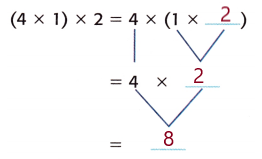
Explanation:
Given, 4 × ( 1 × 2 )
Multiply the factors inside the parentheses first.
4 × 2 = 8
So, ( 4 × 1 ) × 2 = 8.
Question 6.

Answer: 
Explanation:
Given, 2 × (6 × 2 )
Multiply the factors inside the parentheses first.
12 × 2 = 24
So, ( 2 × 6 ) × 2 = 24.
Question 7.
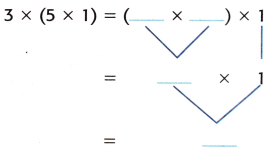
Answer: 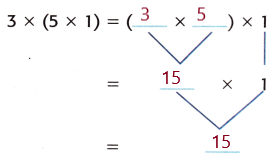
Explanation:
Given, 3 × ( 5 ×1 )
Multiply the factors inside the parentheses first.
3 × 5 = 15
So, ( 3 × 5 ) × 1 = 15.
Question 8.
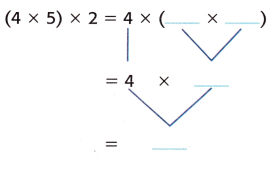
Answer: 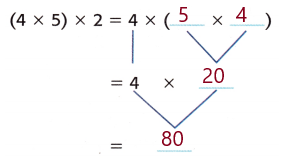
Explanation:
Given, 4 × ( 5 ×2 )
Multiply the factors inside the parentheses first.
4 × 10 = 40
So, ( 4 × 5 ) × 2 = 40.
Problem Solving
Question 9.
Mathematical PRACTICE Use Number Sense Caroline baked bread each day for 5 days for a bake sale. She baked 3 types of bread each day and used 2 cups of flour for each recipe. How many cups of flour did Caroline use?
Answer: Caroline used 30 cups of flour
Explanation:
Caroline baked bread each day for 5 days for a bake sale.
She baked 3 types of bread each day and used 2 cups of flour for each recipe.
That makes, 5 × (3 × 2)
Multiply the factors inside the parentheses first.
5 × 6 = 30
So, ( 5 × 2 ) × 3 = 30.
Hence , Caroline used 30 cups of flour.
Question 10.
Each of the 4 members of the Kings Chess Club play in 3 matches both Saturday and Sunday. How many matches did the chess club play in all?
Answer: The chess club played 24 matches in all
Explanation:
Given, Each of the 4 members of the Kings Chess Club play in 3 matches both Saturday and Sunday.
That makes ,( 4 × 3 ) × 2
Multiply the factors inside the parentheses first.
12 × 2 = 24
So, ( 4 × 3 ) × 2 = 24.
Hence, The chess club played 24 matches in all
Question 11.
Kent works at an ice cream shop. A family of 3 ordered 3 scoops of ice cream each. Then two more families of 3 ordered 3 scoops of ice cream each. How many scoops of ice cream did Kent serve to the three families in all?
Answer: Kent has served 27 scoops of ice cream in all
Explanation:
Given, Kent works at an ice cream shop. A family of 3 ordered 3 scoops of ice cream each.
Then two more families of 3 ordered 3 scoops of ice cream each.
That makes, 3 × ( 3 × 3 )
Multiply the factors inside the parentheses first.
3 × 9 = 27
So, ( 3 × 3 ) × 3 = 27.
Hence, Kent has served 27 scoops of ice cream in all